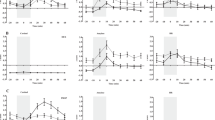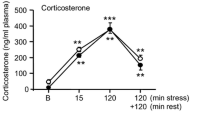Abstract
The effects of a challenge dose of the 5-HT1A agonist, ipsapirone (0.3 mg per kg body weight), or placebo on body temperature and on adrenocorticotrophic hormone (ACTH) and cortisol release, were examined in 30 normal subjects (14 males, 19–74 years and 16 females, 22–69 years) using a randomized, double blind design. Irrespective of age or gender, ipsapirone induced a significant reduction in body temperature relative to placebo and a significant increase in ACTH and cortisol release. Maximal temperature reduction by ipsapirone was significantly blunted in older subjects and was inversely related to age. There was no gender difference in the hypothermic response to ipsapirone. ACTH and cortisol responses showed an opposite impact of aging in males and females. Whereas both responses diminished with age in male subjects, they increased with age in females. The cortisol response of older females was significantly larger than that of all the other subjects. Adverse effects of ipsapirone were also more marked in elderly females and were correlated with ACTH and cortisol responses. These findings should be taken into consideration in the use of ipsapirone and other 5-HT1A agonists as challenge procedures for studying central serotonergic function in depression and other disorders. Careful matching of control and experimental subjects is indicated so as to avoid spurious results which reflect the effects of age and gender rather than the pathophysiology of the disorders being investigated.
Similar content being viewed by others
References
Allen SJ, Benton JS, Goodhardt MJ, Haan EA, Sims NR, Smith CCT, Spillane JA, Bowen DM, Davison AN (1983) Biochemical evidence of selective nerve cell changes in the normal aging human and rat brain. J Neurochem 41:256–265
American Psychiatric Association (1987) Committee on Nomenclature and Statistics. Diagnostic and statistical manual of mental disorders, revised 3rd edn. American Psychiatric Association, Washington, DC
Andreasen NC, Endicott J, Spitzer RL, Winokur G (1977) The family history method using research diagnostic criteria: reliability and validity. Arch Gen Psychiatry 34:1229–1235
Bagdy G, Makara GB (1994) Hypothalamic paraventricular nucleus lesions differentially affect serotonin-1A (5-HT1A) and 5-HT2 receptor agonist-induced oxytocin, prolactin, and corticosterone responses. Endocrinology 134:1127–1131
Biegon A, McEwan BS (1982) Modulation by estradiol of serotonin receptors in brain. J Neurosc 2:199–205
Brett LP, Levine R, Levine S (1986) Bidirectional responsiveness of the pituitary-adrenal system in old and young male and female rats. Neurobiol Aging 7:153–159
Burnett PWJ, Eastwood SL, Harrison PJ (1994) Detection and quantitation of 5-HT1A and 5-HT2A receptor mRNAs in human hippocampus using a reverse transcriptase-polymerase chain reaction (RT-PCR) technique and their correlation with binding site densities and age. Neurosci Lett 178:85–89
Carlsson M, Svensson K, Eriksson E, Carlsson A (1985) Rat brain serotonin: biochemical and functional evidence for a sex difference. J Neural Transm 63:297
Chaouloff F (1993) Physiopharmacological interactions between stress hormones and censerotonersystems. Brain Res Rev 18:1–32
Cutler NR, Sramek JJ, Keppel-Hesselink-JM, Krol-A, Roeschen J, Rickels-K, Schweizer-E (1993) A double-blind, placebo-controlled study comparing the efficacy and safety of ipsapirone versus lorazepam in patients with generalized anxiety disorder: a prospective multicenter trial. J Clin Psychopharmacol 6:429–437
Dillon KA, Gross-Isseroff R, Israeli M, Biegon A (1991) Autoradiographic analysis of serotonin 5-HT1A receptor binding in the human brain postmortem:effects of age and alcohol. Brain Res 554:56–64
Endicott J, Spitzer RL (1978) A diagnostic interview: the schedule for affective disorders and schizophrenia. Arch Gen Psychiatry 35:837–862
Gilbert F, Brazell C, Tricklebank MD, Stahl SM (1988) Activation of the 5-HT1A receptor subtype increases rat plasma ACTH concentrations. Eur J Pharmacol 147:431–437
Goodwin GM, De Souza RJ, Green AR (1985) The pharmacology of the hypothermic response in mice to 8-hydroxy-2(di-n-propylamino)tetralin (8-OH-DPAT): a model of presynaptic 5-HT1 function. Neuropharmacology 24:1187–1194
Goodwin GM, De Souza RJ, Green AR, Heal DJ (1987) The pharmacology of the behavioral and hypothermic responses of rats to 8-hydroxy-2(di-n-propylamino)tetralin (8-OH-DPAT). Psychopharmacology 91:506–511
Greenspan SL, Rowe JW, Maitland LA, McAloon-Dyke M, Elahi D (1993) The pituitary-adrenal glucocorticoid response is altered by gender and disease. J Gerontol 48:M72-M77
Gross-Iseroff R, Salama D, Israeli M, Biegon A (1990) Autoradiographic analysis of age-dependent changes in serotonin 5-HT2 receptors in the human brain postmortem. Brain Res 519:223–227
Haleem DJ, Kennett GA, PS, Curzon G (1989) 8-OH-DPAT increases corticosterone but not other 5-HT1A receptor-dependent responses more in females. Eur J Pharmacol 164:435–443
Hamon M, Emerit MB, El Mestikawy S, Verge D, Daval G, Marquet A, Gozlan H (1987) Pharmacological, biochemical and functional properties of 5-HT1A receptor binding sites labeled by (3H) 8-hydroxy-2-(di-n-propylamino) tetralin in the rat brain. In: Dourish CT, Ahlenius S, Hutson PH (eds.) Brain 5-HT1A receptors. Ellis Horwood, Chichester, pp, 34–51
Hillegaart V (1991) Effects of local application of 5-HT and 8-OH-DPAT into the dorsal and median raphe nuclei on core temperature in the rat. Psychopharmacology 103:291–296
Hruska RE (1986) Elevation of striatal dopamine receptors by estrogen: dose and time studies. J Neurochem 47:1908–1915
Hutson PH, Donohoe TP, Curzon G (1987) Hypothermia induced by putative 5-HT1A agonist LY 165163 and 8-OH-DPAT is not prevented by 5-HT depletion. Eur J Pharmacol 143:121–128
Koenig JI, Gudelsky GA, Meltzer HY (1987) Stimulation of corticosterone andβ-endorphin secretion in the rat by selective 5-HT receptor subtype activation. Eur J Pharmacol 137:1–8
Lawlor BA, Sunderland T, Hill JL, Mellow AM, Molchan SE, Mueller EA, Jacobsen FM, Murphy DL (1989) Evidence for a decline with age in behavioral responsivity to the serotonin agonist,m-chlorophenylpiperazine, in healthy human subjects. Psychiatry Res 29:1–10
Lesch KP (1991) 5-HT1A receptor responsivity in anxiety disorders and depression. Prog. Neuro-psychopharmacol Biol Psychiatry 15:723–733
Lesch KP, Poten B, Soehnle K, Schulte HM (1990a) Pharmacology of the hypothermic response to 5-HT1A receptor activation in humans. Eur J Clin Pharmacol 39:17–19
Lesch KP, Disselkamp-Tietze J, Schmidtke A (1990b) 5-HT1A receptor function in unipolar depression: effect of chronic amitriptyline treatment. J Neural Transm 180:157–161
Lesch KP, Soehnle K, Poten B, Rupprecht R, Schulte HM (1990c) Corticotrophin and cortisol secretion following central 5-hydroxytryptamine-1A (5-HT1A) receptor activation effects of 5-HT receptor andβ-adrenoceptor antagonists. J Clin Endocrinol Metab 70:670–674
Lesch KP, Mayer S, Disselkamp-Tietze J Wiesmann M, Osterheider M, Schulte HM (1990d) 5-HT1A receptor responsivity in unipolar depression: evaluation of ipsapirone-induced ACTH and cortisol secretion in patients and controls. Biol Psychiatry 28:620–628
Lesch KP, Hoh, Disselkamp-Tietze J, Wiesmann M Osterheider M, Schulte HM (1991) 5-Hydroxytryptamine1A (5-HT1A) receptor responsivity in obsessive-compulsive disorder: comparison of patients and controls. Arch Gen Psychiatry 48:540–547
Li Q, Levy AD, Cabrera TM, Brownfield MS, Battaglia G, Van de Kar LD (1993) Long-term fluoxetine, but not desipramine, inhibits the ACTH and oxytocin responses to the 5-HT1A agonist, 8-OH-DPAT, in male rats. Brain Res 630:148–156
Marcusson JO, Oreland L, Winblad B (1984a) Effect of age on human brain serotonin (S-1) binding sites. J Neurochem 43:1699–1705
Marcusson JO, Morgan DG, Winblad B, Finch CE (1984b) Serotonin receptors in aging human brain. Selective reduction of S-2A receptors in frontal cortex and hippocampus. Brain Res 311:51–57
Meltzer HY, Lowy MT (1987) The serotonin hypothesis of depression In: Meltzer H (ed). Psychopharmacology: the third generation of progress. Raven Press, New York
Oshashi M, Fujio N, Kato K, Nawata H, Ibayashi H (1986) Aging is without effect on the pituitary-adrenal axis in men. Gerontology 32:335–339
Pavlov EP, Harman SM, Chrousos GP, Loriaux DL, Blackman MR (1986) Responses of plasma adrenocorticotropin, cortisol, and dehydroepiandrosterone to ovine corticotropin-releasing hormone in healthy aging men. J Clin Endocrinol Metab 62:767–772
Peroutka SJ (1988) 5-Hydroxytryptamine receptor subtypes: molecular, biochemical and physiological characterization. Trends Neurosci 11:496–500
Robson L, Gower AJ, Kendall DA, Marsden CA (1993) Age-related behavioural, neurochemical and radioligand binding changes in the central 5-HT system of Sprague-Dawley rats. Psychopharmacology 113:274–281
SAS (1989) SAS-STAT user's guide, version 6, 4th edn. SAS Institute, Cary, N.C.
Sapolsky R, Armanini M, Packan D, Tombaugh G (1987) Stress and glucocorticoids in aging. Endocrinol Aging 16:965–975
Seeman TE, Robbins RJ (1994) Aging and hypothalmic-pituitary-adrenal response to challenge in humans. Endocrine Rev 15:233–250
Shih JC, Young H (1978) The alteration of serotonin binding sites in aged human brain. Life Sci 23:1441–1448
Spitzer RL, Endicott J, Robins E (1989) Research diagnostic criteria for a selected group of functional disorders. New York Psychiatric Institute, New York
Traber J, Glaser T (1987) 5-HT1A receptor-related anxiolytics. Trends Pharmacol Sci 8:432–437
Waltman C, Blackman MR, Chrousos GP, Riemann C, Harman SM (1991) Spontaneous and glucocorticoid-inhibited adrenocorticotropic hormone and cortisol secretion are similar in healthy young and old men. J Clin Endocrinol Metab 73:495–502
Young LT, Warsh JJ, Li PP, Siu KP, Becker L, Gilbert J, Hornykiewicz O, Kish SJ (1991) Maturational and aging effects on guanine nucleotide binding protein immunoreactivity in human brain. Dev Brain Res 61:2430–248
Author information
Authors and Affiliations
Rights and permissions
About this article
Cite this article
Gelfin, Y., Lerer, B., Lesch, K.P. et al. Complex effects of age and gender on hypothermic, adrenocorticotrophic hormone and cortisol responses to ipsapirone challenge in normal subjects. Psychopharmacology 120, 356–364 (1995). https://doi.org/10.1007/BF02311184
Received:
Revised:
Issue Date:
DOI: https://doi.org/10.1007/BF02311184




